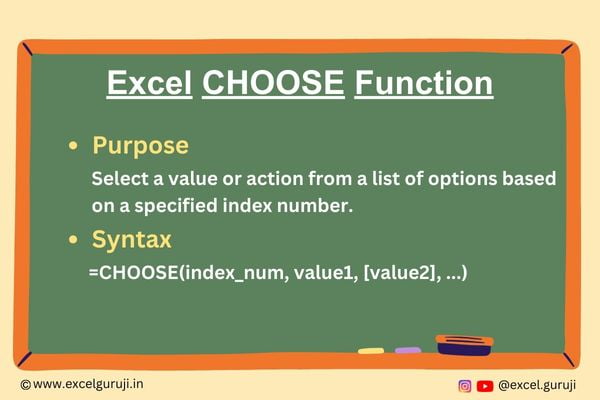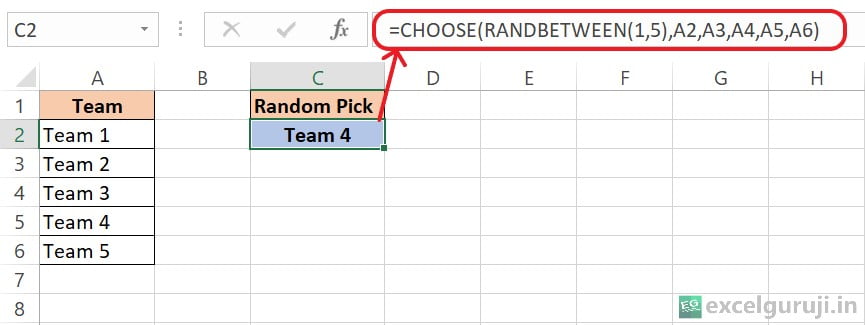Contents
Excel CHOOSE Function

When to Use the Excel CHOOSE Function in Excel
The CHOOSE function in Excel is a versatile tool that allows you to pick a value or action from a list based on a specified index number. It comes in handy when you have a list of options, and you need to select one of them based on a given position or index.
What Excel CHOOSE Function Returns
The Excel CHOOSE function returns a value or action from a list of options based on the index number you provide. It essentially allows you to make a choice from a predefined set of values.
Syntax of Excel CHOOSE Function
The syntax of the Excel CHOOSE function is as follows:
=CHOOSE(index_num, value1, [value2], …)
Input Arguments
Here are the input arguments for the Excel CHOOSE function:
● index_num: This is the index or position of the value you want to choose from the list. It must be a positive integer.
● value1, value2, …: These are the options or values you want to choose from. You can provide up to 254 values, but you need a corresponding index number for each value.
Extra Notes
● If the index_num is less than 1 or greater than the number of values provided, the CHOOSE function returns a #VALUE! error.
● You can use a cell reference for the index_num and the values, making it dynamic and responsive to changes.
● If the index_num is a fraction, it is rounded down to the nearest integer before being applied.
● If you use an array for the index, every value in that array is checked when CHOOSE is used.
● You can use either single values or a range of values as options in CHOOSE.
Examples of the Excel CHOOSE Function
Here are few examples of using the CHOOSE function in Excel:
Example 1: Basic Usage
Suppose you have a list of fruit names, and you want to select a fruit name based on its position. You can use the following formula:

- In the first formula, =CHOOSE(1,”Apple”,”Banana”,”Mango”), the index number is 1, so it selects the value at position 1, which is “Apple”
- In the second formula, =CHOOSE(2,”Apple”,”Banana”,”Mango”), the index number is 2, so it selects the value at position 2, which is “Banana”.
- In the third formula, =CHOOSE(3,”Apple”,”Banana”,”Mango”), the index number is 3, so it selects the value at position 3, which is “Mango”.
Example 2: Randomly Select a Team with Excel CHOOSE Function.
Imagine you are organizing a friendly sports event, and you have five teams competing – Team 1, Team 2, Team 3, Team 4, and Team 5. You want to use Excel to randomly select one of these teams as the starting team for your event.
To achieve this, you decide to employ the Excel CHOOSE function along with the RANDBETWEEN function. This will enable you to make an unbiased, random choice from the list of teams.

The formula =CHOOSE(RANDBETWEEN(1,5),A2,A3,A4,A5,A6) has a specific function:
RANDBETWEEN(1,5) generates a random number between 1 and 5 every time the worksheet is recalculated, which happens automatically when there is a change in the data or formulas on the sheet, or manually by pressing the F9 key.
The CHOOSE function then uses this random number as the index to select one of the values: A2, A3, A4, A5, or A6.
So, when you enter this formula, it will randomly choose one of the team names (Team 1 to Team 5) from cells A2 to A6 based on the random number generated by RANDBETWEEN(1,5).
This is useful if you want to make a random selection from a list of options, such as choosing a team for a game or a random winner from a group of participants.
Conclusion
In summary, the Excel CHOOSE function is a powerful tool for making selections from a list of options based on a specified index.
Whether you are working with data, creating dynamic reports, or building interactive spreadsheets, the CHOOSE function can streamline your Excel tasks and enhance your efficiency.
As with any Excel function, practice and experimentation are key to mastering the CHOOSE function. Start using it in your projects today and explore the many possibilities it offers.
Frequently Asked Questions (FAQs)
Q1: Can the CHOOSE function be used for non-numeric index numbers?
A1: No, the CHOOSE function requires a positive integer as the index number.
Q2: Is there a limit to the number of values you can provide in the CHOOSE function?
A2: You can provide up to 254 values in the CHOOSE function.
Q3: What happens if the index number is out of the range of provided values?
A3: If the index number is less than 1 or greater than the number of values, the CHOOSE function returns a #VALUE! error.
Q4: Can you use a cell reference for the index number and values in the CHOOSE function?
A4: Yes, you can use cell references to make the CHOOSE function dynamic and responsive to changes.
Q5: When should I use the CHOOSE function instead of other lookup functions in Excel?
A5: The CHOOSE function is particularly useful when you have a fixed set of options and you need to make selections based on an index. If you have a larger dataset or need more complex lookup functionality, other functions like VLOOKUP or INDEX/MATCH may be more appropriate.
Other Related Excel Functions
Mastering Excel CHOOSECOLS Function: Custom Data Extraction and Analysis
Mastering Excel CHOOSEROWS Function: Select and Extract Rows Like a Pro
Join me on Instagram, YouTube and WhatApp Channel for your daily dose of valuable tips and tricks! Catch insightful videos that will enhance your knowledge and skills. Don’t miss out – follow me now!